
“He makes the winds His messengers, flaming fire His ministers.” —Psalm 104:4
The Eruption of Krakatoa, August 27, 1883
 ut for a walk on a summer Sabbath in 1884, boys from a mission school on the island of Zanzibar, East Africa, spotted a strange looking object stranded on a sandbar in the ocean. Upon closer inspection, it proved to be a black island of pumice on which were dozens of human skeletons, monkeys, and a couple of Bengal tiger’s bones. They had floated on the ocean for nine months, more than 4,600 miles, after the volcanic explosion and disappearance of 70% of the Island of Krakatoa between the the colonial Dutch-controlled Islands of Sumatra and Java. As the first great natural catastrophe in the age of communication, the sound of the explosion was heard 3,000 miles away and the reportage of it zoomed around the world on transoceanic cables. The volcano’s explosion was about 13,000 times the nuclear yield of the atomic bomb dropped on Hiroshima. ut for a walk on a summer Sabbath in 1884, boys from a mission school on the island of Zanzibar, East Africa, spotted a strange looking object stranded on a sandbar in the ocean. Upon closer inspection, it proved to be a black island of pumice on which were dozens of human skeletons, monkeys, and a couple of Bengal tiger’s bones. They had floated on the ocean for nine months, more than 4,600 miles, after the volcanic explosion and disappearance of 70% of the Island of Krakatoa between the the colonial Dutch-controlled Islands of Sumatra and Java. As the first great natural catastrophe in the age of communication, the sound of the explosion was heard 3,000 miles away and the reportage of it zoomed around the world on transoceanic cables. The volcano’s explosion was about 13,000 times the nuclear yield of the atomic bomb dropped on Hiroshima.
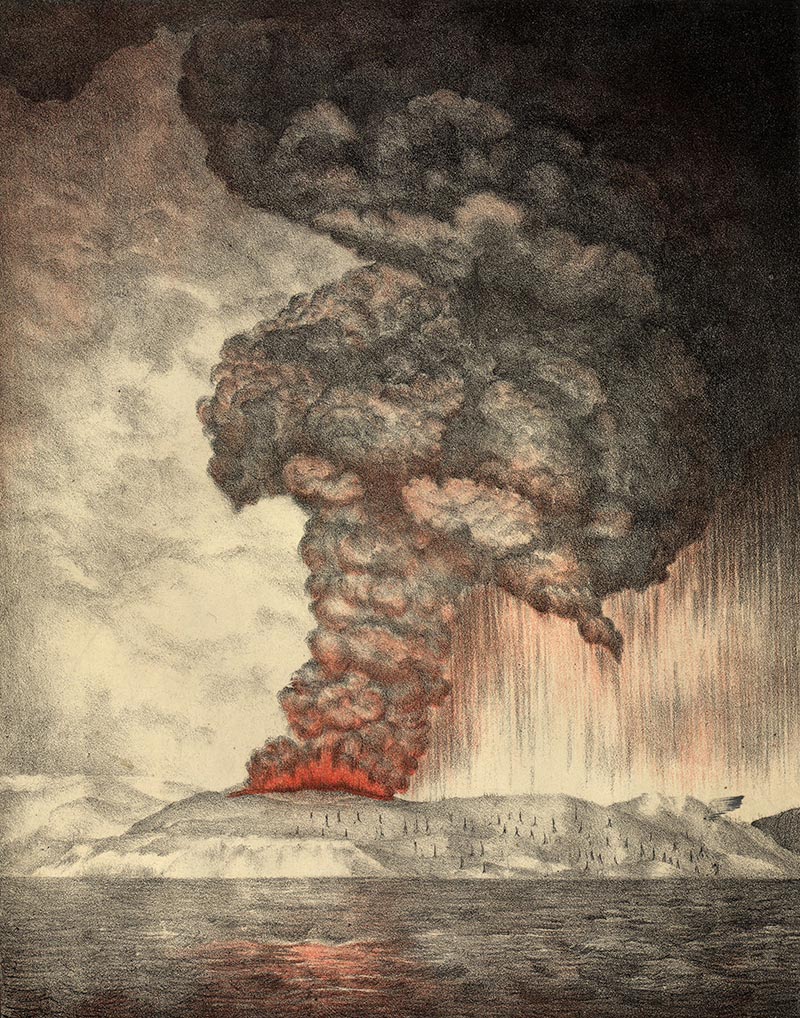
An 1888 lithograph of the 1883 eruption of Krakatoa
Indonesia is made up of hundreds of volcanic islands, a number of which sit on a “subduction” zone of tectonic plates under the ocean. Krakatoa was located above where the archipelago bends slightly in the Sunda Strait. Seismic events were carefully recorded in the Dutch capital of Batavia (now Jakarta) eighty-three miles away, and other stations around the East Indies, in the years and months leading up to the Krakatoa explosion. In May and June, thick black columns emanated from fissures on Krakatoa, as well as explosions, observed by mariners of several nations whose ships plied the Sunda Straits. A Dutch engineer was sent to investigate ongoing activity on the island and reported three major ash columns and almost two feet of ash on the island. All flora had died and he counted at least eleven new steam vents. By August 26, the dark plume over Krakatoa had reached about seventeen miles high.

Krakatoa is a volcanic island situated in the Sunda Strait between the islands of Java and Sumatra in the Indonesian province of Lampung
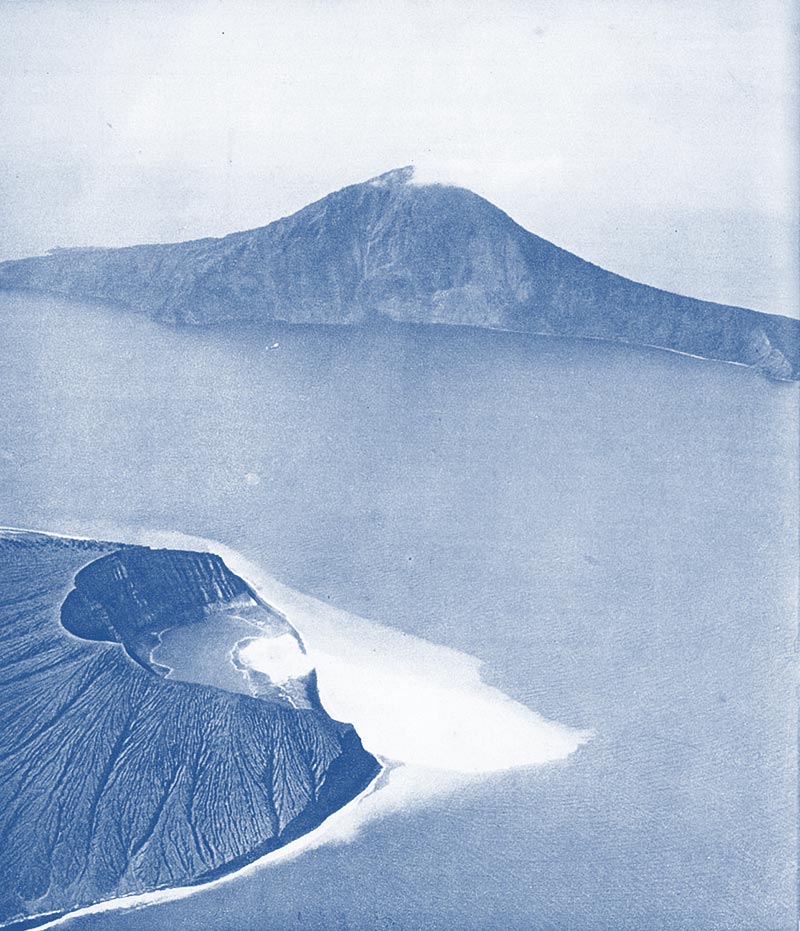
An aerial view circa 1952 of the fragmented remains of the volcanic island of Krakatoa
|
The following day, four large explosions split the air. The final one at 10:00am was so enormous that it was heard in Perth, Australia, and the island of Mauritius, both more than 3,000 miles away. Each explosion caused a shock wave and a tsunami, the final one emanating out at about 675 miles per hour. The pressure wave registered on bargraphs around the world and ruptured the eardrums of sailors on ships more than forty miles away! Few people died from the explosion itself but the more than one-hundred-foot tsunamis caused from the huge pyroclastic flows and shock waves of the explosion engulfed villages, towns, and entire islands, killing more than 36,000 people.
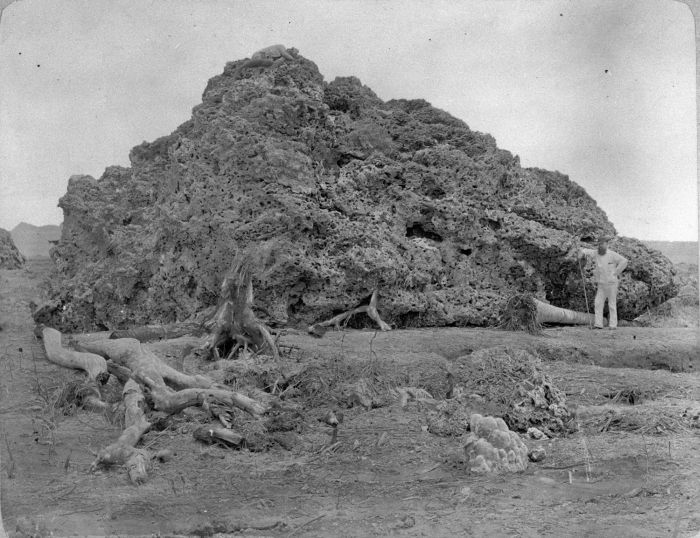
Coral block thrown onto the shore of Java after the Krakatoa eruption of 1883
The news of the disaster flew around the world on undersea cables, dispatches from news services and communication networks never before put to the test in such a circumstance. In a real way, the news of Krakatoa demonstrated that a new era of communication had arrived, uniting the world of information virtually unknown before this time.
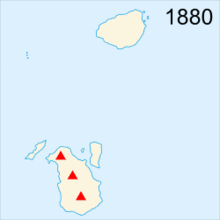
Krakatoa’s changes over time
|
The after-effects of the volcano’s explosion resulted in a number of historic climatic anomalies. With millions of tons of ash and unprecedented amounts of sulfuric acid in the stratosphere, global temperatures fell, causing increased rainfall, especially “acid rain.” The eruption darkened the sky and created spectacular sunsets for more than a year. A series of famous paintings of the skies were produced in countries as far apart as the United States and the United Kingdom. According to the best-selling book on the volcano, entitled Krakatoa, by Simon Winchester, many of the subordinated Muslim population of Indonesia revolted against their colonial overseers from the Netherlands, believing Allah was displeased with colonialism, culminating a number of years later in the expulsion of the Dutch and the establishment of Indonesian independence.
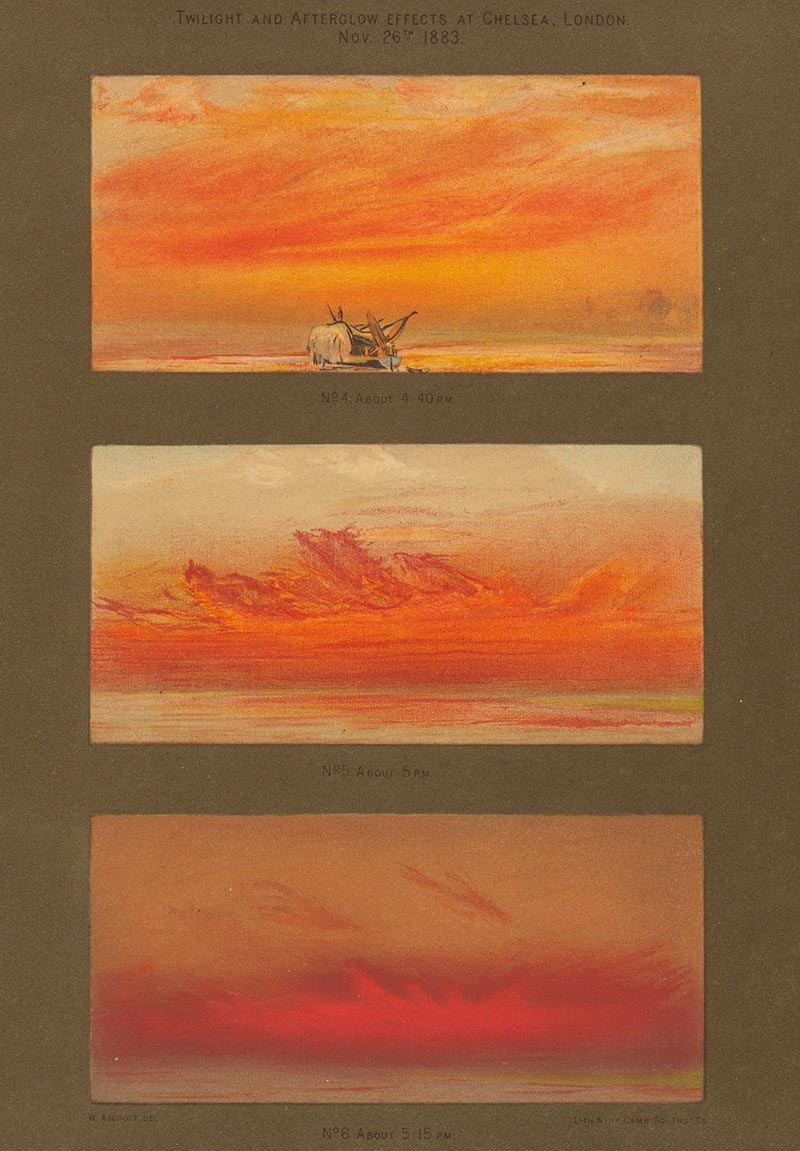
Three of a series of 1883 paintings by British artist William Ascroft depicting the atmospheric effects caused by the Krakatoa explosion as seen in England
Scripture tells us that God oversees his creation, including the control of weather and of the earth itself, and uses such disasters to fulfill his purposes. While there are natural explanations of how such events take place, those explanations are within the secondary causal realm of God’s decretive will. His purposes, however, are past knowing — sometimes as judgement, sometimes as warning, sometimes as giving permission to Satan to persecute or destroy, moving history in a particular direction. We ought not speculate on such things but submit to Him as all Wise, and fulfilling whatsoever comes to pass as part of His divine plan, as hard as that may seem in such disastrous circumstances.

Image Credits:
1 Krakatoa eruption lithograph (Wikipedia.org)
2 Indonesia map (Wikipedia.org)
3 Krakatoa aerial view (Wikipedia.org)
4 Coral block (Wikipedia.org)
5 Animated Map (Wikipedia.org)
6 Ascroft Krakatoa paintings (Wikipedia.org)
|







